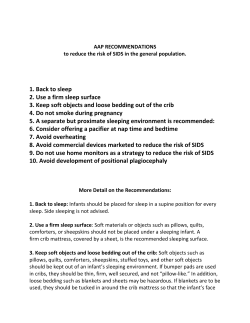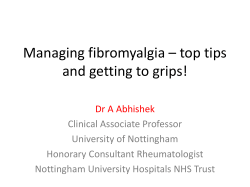
Brief Background Information about Sudden Unexpected
Sudden Unexpected Infant Death (SUID) is the sudden and unexpected death of an infant (less than one year of age) in which the manner and cause of death are not immediately obvious prior to investigation. Based on diagnostic criteria by the Centers for Disease Control and Prevention, most SUIDs are reported as one of three types of infant deaths: Sudden Infant Death Syndrome (SIDS), unknown cause, and accidental suffocation and strangulation in bed (ASSB). Sudden Infant Death Syndrome (SIDS) is the sudden death of an infant less than 1 year of age that cannot be explained after a thorough investigation is conducted, including a complete autopsy, examination of the death scene, and a review of the medical history. Unknown Cause is the sudden death of an infant less than 1 year of age that cannot be explained. Often a thorough investigation was not conducted and cause of death could not be determined. Accidental Suffocation and Strangulation in Bed is the leading cause of infant injury death. Causes of accidental suffocation or strangulation include: • Suffocation by soft bedding, such as when a pillow or waterbed mattress covers an infant’s nose and mouth. • Overlay—when another person rolls on top of or against the infant while sleeping. • Wedging or entrapment— when an infant is wedged between two objects, such as a mattress and wall, bed frame, or furniture. • Strangulation, such as when an infant’s head and neck become caught between crib railings. Brief Background Information about Sudden Unexpected Infant Death, Safe Sleep Practices, and Breastfeeding Saving Babies’ Lives While there are many issues that contribute to the unacceptably high rates of infant mortality in the United States, there is the possibility to prevent up to 14% of infant deaths—those categorized as Sudden Unexpected Infant Death (SUID)—by changing the ways babies are put down to sleep. In 2013, there were a total of 3,434 SUID related deaths (these include 1,563 attributed to Sudden Infant Death Syndrome (SIDS); 1052 attributed to unknown cause, and 819 attributed to accidental suffocation and strangulation in bed). While a small portion of deaths included in this calculation may not be preventable due to genetic abnormalities, arousal defects, and other non-modifiable causes, experts agree that the adoption of safe sleep behaviors could have a preventive impact on up to the 14% of infant mortality data classified as sleep-related deaths.1 Why SUID rather than SIDS? In 1969, the term Sudden Infant Death Syndrome (SIDS) was proposed to describe a clinical entity with characteristic findings to diagnose the sudden unexplained deaths of infants, typically during their sleep. In 1974, federal legislation was passed to fund research and establish programs to provide information and counseling to families following a SIDS death. Based on epidemiologic research that sleep position—prone sleeping—was a significant risk factor for SIDS and on monitoring of the success of similar campaigns to change sleep position in other countries, the Back To Sleep Campaign (BTS) began in 1994 as a way to educate parents, caregivers, and health care providers about ways to reduce the risk for SIDS. Utilizing effective partnerships and collaboration, BTS led to a decline of SIDS rates by more than 50%. Recognizing that placing an infant on his/her back to sleep could significantly reduce the risk of SIDS, both family support and advocacy organizations and state SIDS programs expanded their efforts to disseminate this key public health message. By 1999, however, despite decreases in SIDS deaths, there was a leveling off, and in some following years, a slight increase in unexpected infant deaths overall. It became clear that many infant deaths that might have been classified as SIDS by coroners and medical examiners were being identified as accidental suffocation/strangulation in bed or undetermined, because there was more information about the sleep situation in which the baby was found and there were potential explanations for the death.2 It thus became important to understand the factors that contributed to those unsafe sleep situations to continue to decrease infant mortality. Thus the concept of Sudden Unexpected Infant Death (SUID) that included all of those types of deaths came into use to aid researchers in understanding sleeprelated infant deaths. Disparities in SIDS/SUID deaths. SIDS and overall SUID deaths reported among Black populations are nearly twice those of White populations. Similarly, American Indian/Alaska Native populations experience much higher SIDS rates than White populations.2 Not surprisingly, given the disparities in death rates, disparities also exist in adoption of risk reduction behaviors. In addition, other risk factors (such as smoking) and lack of protective factors (such as breastfeeding) are more common among Black and American Indian/Alaska Native families, the two populations most impacted by SUID.3 A variety of societal factors including poverty and the impact of racism and discrimination contribute to these disparities. A key challenge for the field is how to better communicate about safe sleep and support caregivers to use safe sleep practices in ways that are effective with all populations, including those who have the highest rates of SUID deaths. What are safe sleep behaviors? To reduce the risk of SIDS and other sleep-related infant deaths, the American Academy of Pediatrics (AAP) provides a set of evidence based recommendations. It recommends that all infants be placed on their backs Key Safe Sleep Recommendations to reduce the risk of SUID based on the American Academy of Pediatrics Task Force on SIDS. Always place your baby on his or her back to sleep, for naps and at night. Use a firm sleep surface, such as a mattress in a safety-approved crib, covered by a fitted sheet. Room share—give your baby his or her own sleep area in the same room as you or others. Baby should not sleep in a chair or on a couch—alone or with others. Keep soft objects, toys, crib bumpers, and loose bedding out of your baby's sleep area. Breastfeed. Avoid smoke exposure during pregnancy and after birth. Offer baby a dry pacifier that is not attached to a string for naps and at night once breastfeeding is established. Keep baby from overheating during sleep. (known as supine position) by their caregiver for every sleep until 1 year of age. It also recommends that infants sleep on a firm sleep surface, without loose bedding, in the same room but not the same bed or sleep surface as parents or other persons. Bed-sharing can increase the risk of SIDS and suffocation. Sleeping with a baby on a couch or in a chair is even more risky. Resources to educate caregivers regarding ways to reduce the risk for SIDS and other sleeprelated causes of infant death are provided by the Safe to Sleep® campaign (previously known as the Back to Sleep campaign). This collaborative effort was renamed and expanded in 2012 to reflect the AAP’s broader recommendations and to address all sleep-related infant deaths. Breastfeeding and Infant Survival and Well-being In the United States, feeding babies with formula has become the norm, despite the many advantages of breastfeeding. Breastfeeding provides many benefits to infants including more balanced nutrition, protection against infections, long-term health benefits such as decreased likelihood of developing Type 1 diabetes, asthma, or obesity and better survival during the first year of life with decreased risk of SIDS. In addition, benefits for intellectual and emotional development have been related to breastfeeding. As a result, the American Academy of Pediatrics recommends that babies be exclusively breastfed for the first six months of life, followed by continued breastfeeding as complementary foods are introduced, with continuation of breastfeeding for 1 year or longer as mutually desired by mother and infant. In addressing infant survival, the issue of promoting breastfeeding is crucial. A challenge for the field is better integrating promotion of breastfeeding and safe sleep, so that sleep practices both support breastfeeding and address safety. Infant Caregivers Need Help When a new baby is born, the two biggest challenges are feeding and sleeping. Successful breastfeeding and safe sleep practices can be challenging. Even parents who know about the benefits of safe sleep and breastfeeding sometimes choose not to adopt them. There are many reasons for this. Sometimes parents and other infant caregivers hear conflicting information about safe sleep and about breastfeeding. Parent/caregiver attitudes can be influenced by views of other family and community members, personal and cultural beliefs, practical barriers, and lack of social and economic supports from the community and workplace. A challenge for the field is developing ways to provide individualized conversations with parents and other infant caregivers and their support systems to help overcome barriers to safe sleep and breastfeeding. Making Safe Sleep Everybody’s Business The challenges in the field to supporting caregivers and their communities to use safe sleep practices and to promote breastfeeding are many and complex. It will take a broad coalition of traditional safe sleep and breastfeeding proponents and many new partners to achieve success. Because addressing sudden unexpected deaths of infants is the kind of complex issue with multiple constituencies and programs the time is now ripe for a systems integration approach. Bringing together organizations, community leaders, public programs, government, and others who have a stake in keeping babies alive and developing well in a systematic way can expand the scope of efforts and create sustainable, long-term solutions. A system can be defined as an organized, purposeful structure that consists of a complex network of interrelated stakeholders that continually influence one another to maintain activities to achieve the goal of making safe infant sleep a national norm.4 The systems approach entails creating relationships, building infrastructure to sustain the system and its activities, assuring consistent, sustainable resources, and creating an inclusive process to achieve goals. A challenge for the field is creating, at the state and local levels, active coalitions that create integrated systems to address safe sleep and breastfeeding. References 1 Centers for Disease Control and Prevention, National Center for Health Statistics. Underlying Cause of Death 1999-2013 on CDC WONDER Online Database, released 2015. Data are from the Multiple Cause of Death Files, 1999-2013, as compiled from data provided by the 57 vital statistics jurisdictions through the Vital Statistics Cooperative Program. Accessed at http://wonder.cdc.gov/ucd-icd10.html on Mar 31, 2015 11:33:49 AM 2 Shapiro-Mendoza, C. K., Kimball, M., Tomashek, K. M., Anderson, R. N., & Blanding, S. (2009). US infant mortality trends attributable to accidental suffocation and strangulation in bed from 1984 through 2004: are rates increasing?. Pediatrics, 123(2), 533-539. 3 4 U.S. Maternal and Child Health Bureau. (2013) Child Health USA 2013. Author:Rockville, MD. WebFinance, Inc. System. In WebFinance, Inc. BusinessDictionary.com [website]. http://www.businessdictionary.com/definition/system.html#ixzz3MHThQyYt
© Copyright 2025








